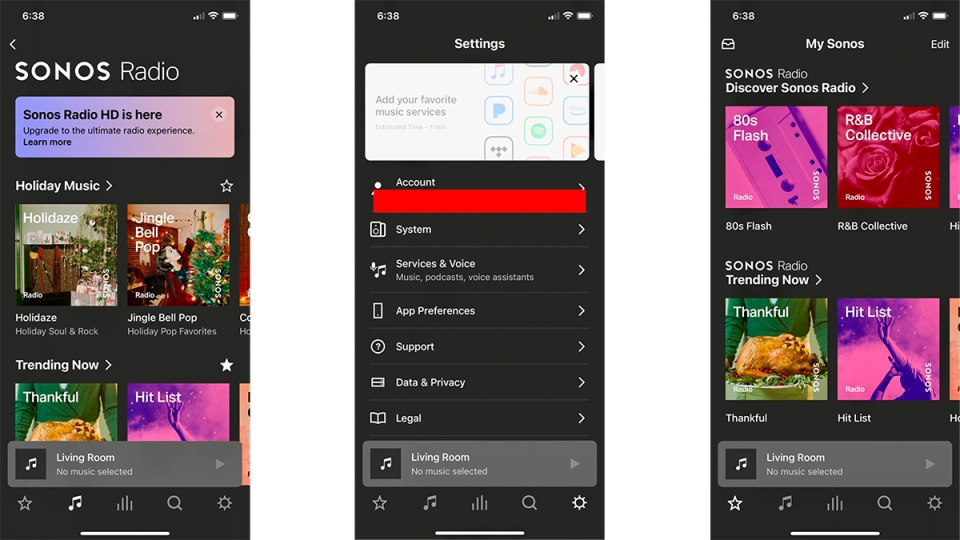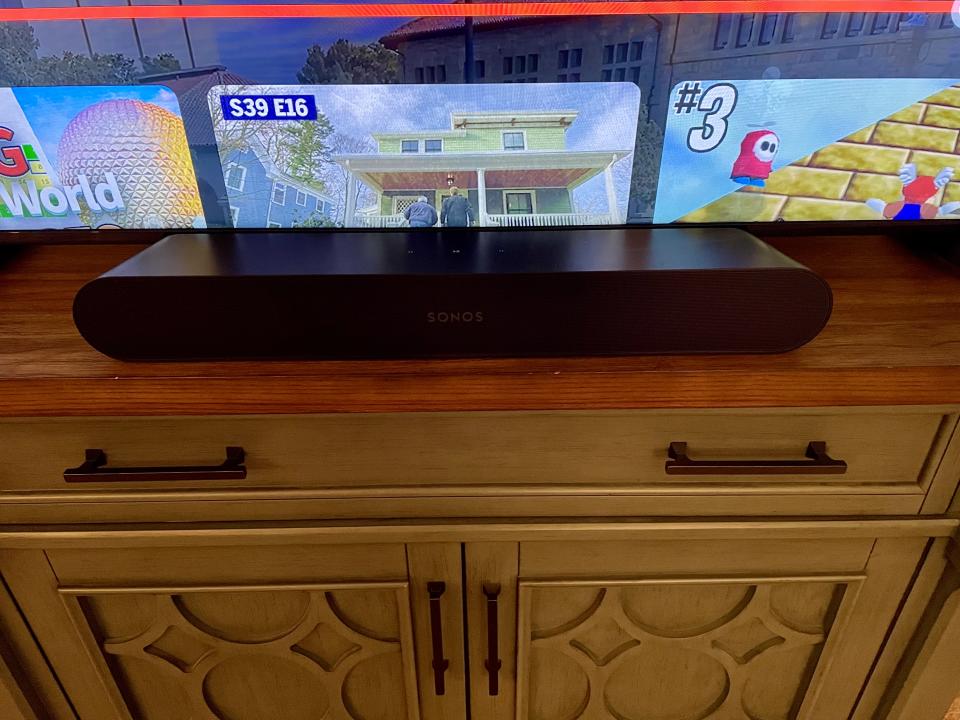Sonos Ray Review: Our Favorite Budget-Friendly Soundbar

Our editors independently select the products we recommend. We may earn a commission on items bought through our links.
Table of Contents
Today's Top Deals
View More
While TV speakers are slowly getting better, there’s still no replacing the kind of audio that an exceptional soundbar can deliver. And when it comes to these audible TV companions, one of the best in town is the Sonos Ray.
We had the opportunity to review the company’s newest and smallest soundbar to see if it does in fact live up to our expectations of Sonos quality sound.
Built for bedrooms and smaller TV-watching environments, the Ray ditches HDMI ARC/eARC in favor of a digital optical port — a telltale sign that the audio device is not going to deliver anything close to surround sound. In many cases though, we actually found the Sonos Ray to be more capable than its connections would lead one to believe.

ANOTHER WIN FOR SONOS
Sonos Ray
Buy Now On Amazon
$279 at walmart
$279 at best buy
Pros
Great sound quality
Easy setup and controls
Simple to expand
Sonos App is packed with features
Cons
No HDMI ARC/eARC
No Dolby Atmos support
Not as powerful as the Sonos Beam
Sonos Ray: What’s in the Box
Available in matte black and white finishes, the Sonos Ray measures 22 inches wide, 2.79 inches tall, 3.74 inches from front to back, and weighs 4.29 pounds.
Borrowing the grille overlay of the Sonos Beam and Arc, the front of the Ray is slightly curved on the left and right. Paired with the wavelength-guided design of the main drivers, this helps to evenly disperse sound throughout small to medium-sized listening spaces.
Up top, there are buttons for play/pause and volume up/down, with a swipe left-or-right gesture mapped for track skipping. Unlike the Sonos Beam and many of Sonos’ other speakers, there’s no microphone toggle on the Ray because the soundbar doesn’t have an integrated voice assistant, like Alexa, to work with.

On the back of the soundbar, there’s a Join button, a DC power port, an Ethernet port, and a digital optical input.
Other box contents include a six-foot power cord, a five-foot optical cable, and some documentation.
Sonos Ray Features
Far more than just a traditional soundbar, the Sonos Ray is a true-blue Sonos component from top to bottom, meaning you’ll be able to add the speaker to a new or existing Sonos “zone,” allowing you to group the soundbar in with other Sonos speakers or treat it as a standalone peripheral.
And similar to other Sonos hardware, you’ll be able to have multiple speakers (including the Ray) playing the same audio source at once, or have each individual speaker playing something different.

Thanks to AirPlay 2 and Spotify Connect, the Sonos Ray can easily be used as a dedicated music speaker when your TV is turned off, and the incredible Sonos app grants you access to an immense library of other music, radio, and podcast-streaming services.
One of the best parts of any Sonos ecosystem is the ability to expand, and while the Sonos Ray is a more-than-capable replacement for TV speakers, you may find that you want to add additional speakers (or a subwoofer) down the line.
With the Ray, we recommend pairing a set of Sonos One speakers to be used as rear-left and rear-right surround channels, and the Sonos Sub Mini for some extra bass.
Setting Up the Sonos Ray
Once you’ve plugged your Ray into power and connected it to your TV’s optical output, you’ll want to go ahead and download the Sonos S2 app (for iOS and Android devices) if you haven’t done so already.
If this is your first time using any kind of Sonos gear, you’ll first need to create a Sonos account, which the app will walk you through step-by-step. After your account is created, tap Set up a new system, then tap Add. The Sonos app will then go about scanning your Wi-Fi network for available Sonos devices and will prompt you to add the Ray once it’s detected.

If you already own a Sonos system, all you’ll have to do is open the app, tap Settings > System > Add Product, and allow the app to scan your network for the Ray.
If you’re using an iOS device, you’ll be able to fire up Sonos’ Trueplay feature during setup (you can access this feature later on, too) which will calibrate your Ray’s sound based on the environment in which it’s placed.
The Sonos app will also walk you through pairing your TV’s remote to the Ray, a process that can be a little finicky if the remote in question uses radio-frequency or Bluetooth, in addition to IR. As for me though, my Samsung TV’s remote (IR-only) paired successfully the first time around.
Listening to Film and TV With the Sonos Ray
In terms of overall soundstage, the Sonos Ray delivers the kind of immersion that sticks it a few notches above some of the most basic soundbars on the market, while also cementing its bottom-rung position in Sonos’ soundbar hierarchy. And while “bottom-rung” may seem like an insult, we assure you, that’s not the case.
From the ground up, the next-in-line Sonos Beam is quite literally the more capable soundbar of the two — from its HDMI ARC/eARC integration to its driver array and overall power. But that doesn’t mean that the Ray should be ignored. In fact, for most folks looking to bypass the tinny audio of most TV speakers, the Sonos Ray is one of the best soundbars you can get your hands on for under $300.
Rocking four Class-D amps, two tweeters, and two mid-woofers, the Sonos Ray delivers bright and detailed treble and midrange, with some admirable presence in the low-end, too — and that’s without a dedicated sub.

To take the soundbar for one of many test drives, I threw on several scenes from the original “John Wick.” The Sonos Ray did a great job at capturing the film’s many adrenaline-fueled spectacles, with punches, kicks, gunfire, and explosions receiving plenty of heft in the overall mix, while essential dialogue was rendered clear and articulate.
Considering the fact that the digital optical connection can only muster Stereo PCM sound, Dolby Digital, and DTS, it was pretty amazing how engulfing “John Wick” felt at times. But then there was another handful of scenes where the mix shrank down to a smaller soundstage, reminding me that I was, of course, working with a stereo-only soundbar.
As for something a little more dialogue-driven, I turned to AMC’s “Mad Men.” A show that leans on the spoken word, the Sonos Ray did a solid job at annunciating, and without trampling over other parts of the mix, where subtle background sounds like office chatter, typewriters-a-plenty, and vehicle traffic through open windows were free to roam. And while the Speech Enhancement feature added a little extra presence, the difference between having it on or off was barely noticeable.
Listening to Music With the Sonos Ray
Music is another big win for the Sonos Ray.
“Am I Really Going to Die” is the opening track of White Lies’ “As I Try Not to Fall Apart,” an electronic armada of disco-flavored synths and winding melodies, and it gained some serious height through the soundbar. Sure, it wasn’t the fully three-dimensional immersion of Dolby Atmos, but for a mini-soundbar, the track sounded much bigger to me than I’m used to hearing through headphones and other speakers.
Switching over to Frank Ocean’s “Blonde,” the track “Siegfried” presents an echo-laden vocal performance that plays mostly from the middle, but tends to bounce, a playful bit of phasing that the Sonos Ray beautifully captured, to the point where it sounded like the soundbar had a dedicated center-channel. And when Ocean performs his end-of-track rap abstraction, his vocals rise up in the mix and shed their reverb, a soft air-brushing of sound that the Ray made even richer.

Of course, the addition of a Sonos woofer may be something that movie diehards and gamers consider, but this isn’t a purchase one has to jump on, necessarily.
Sonos was kind enough to send me a Sub Mini that I’ll be covering in a separate review, and while the soundstage was definitely meatier with the Mini linked up, it wasn’t a component I felt I would have to (or want to) use all the time.
The Verdict: Should You Buy the Sonos Ray?
The Sonos Ray doesn’t quite deliver the Dolby Atmos immersion of the Sonos Beam or flagship Sonos Arc, but as the company’s smallest soundbar to date, the Ray is one of the best alternatives to those lackluster 15-watt speakers on your Samsung LED or LG OLED.
Delivering punchy and detailed sound, without the need for a dedicated woofer, the Ray is a true enhancement for all your favorite movies, shows, video games, and music.

ANOTHER WIN FOR SONOS
Sonos Ray
Buy Now On Amazon
$279 at walmart
$279 at best buy
More Top Deals from SPY
Best of SPY
Click here to see more up-to-date holiday deals!